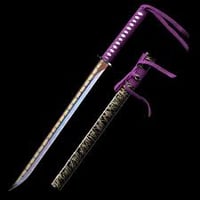The origin of the katana
The katana, a traditional Japanese sword renowned for its exceptional craftsmanship and deadly effectiveness, holds a rich and storied history that stretches back centuries. Its origins can be traced to ancient Japan, where it evolved from earlier sword-making techniques.
.jpg?width=301&height=167&name=images%20(6).jpg)
The term "katana sword" refers specifically to the traditional Japanese sword characterized by its distinctive curved, single-edged blade and long grip. While the word itself has become synonymous with Japanese swords in general, it primarily denotes the iconic design that emerged during the Muromachi period (1336–1573) and reached its peak during the Edo period (1603–1868).
The evolution of the katana began with the development of the tachi, a predecessor characterized by a similar curved blade. Initially worn suspended edge-downward from the waist, the tachi was primarily used by samurai on horseback. However, as battlefield tactics shifted and the demand for more versatile weaponry arose, the need for a more efficient sword became apparent.
During the Kamakura period (1185–1333), swordsmiths experimented with various techniques to enhance the strength, flexibility, and cutting power of their blades. This period saw the emergence of the uchigatana, a precursor to the katana that was worn edge-upward and gradually became favored by foot soldiers and infantry due to its versatility in close combat.
The true katana as we recognize it today came into prominence during the Muromachi period. This era saw innovations in swordsmithing techniques, including the use of differential hardening and folding methods to create blades of exceptional sharpness and durability. The katana's design underwent refinements to optimize its balance, handling, and cutting performance.
One of the most significant advancements in katana craftsmanship was the introduction of the differential hardening process, known as "clay tempering" or "yakiba." This technique involved applying a special clay mixture to the blade before quenching, resulting in a distinctive hamon line—a visible boundary between the hardened edge and the softer spine. The hamon not only added aesthetic beauty to the sword but also contributed to its strength and resilience.
The Edo period marked the zenith of katana production, with master swordsmiths such as Masamune and Muramasa achieving legendary status for their unparalleled skill and artistry. The katana became not only a symbol of the samurai's status and honor but also a revered cultural icon embodying the spirit of bushido, the way of the warrior.
The image of the "black katana" often conjures notions of mystery and intrigue. While traditional katana blades were typically forged from carbon-rich steel and adorned with elaborate hamon patterns, the term "black katana" may refer to swords with darker, unadorned finishes or those associated with shadowy legends and folklore.
In modern times, the katana continues to captivate enthusiasts worldwide, revered not only for its historical significance but also for its timeless elegance and deadly efficiency. Whether displayed as a work of art or wielded in martial arts practice, the katana remains an enduring symbol of Japan's martial heritage and cultural legacy.
